With the improvement in living standards and the advent of an aging society, residential elevators have gradually become a standard feature in villas, duplexes, and age-friendly homes.
1. Hydraulic Residential Elevator
The main types of household hydraulic elevators are backpack type, with oil cylinders on both sides of the car, evenly distributed force, and space saving; Side mounted, with the oil cylinder located on one side of the elevator car, allowing for flexible utilization of the shaft space; Built in, the oil cylinder is hidden inside the elevator car, with a simple and beautiful appearance; No foundation pit type, no need for deep excavation, easy installation, suitable for households that are inconvenient for large-scale civil engineering.
Features & Functionality
Hydraulic elevators use a hydraulic cylinder to drive the cabin, offering smooth operation suitable for low-rise homes (typically 2-5 floors).
Advantages
High load capacity (usually 300-500kg), ideal for moving furniture or wheelchairs.
Quiet operation, suitable for noise-sensitive households.
Mature technology with relatively low maintenance costs.
Disadvantages
Requires a machine room or hydraulic cylinder space, occupying some area.
Hydraulic oil may leak, requiring regular maintenance.
High energy consumption, leading to higher long-term electricity costs.
Ideal For
Villas and standalone homes, especially those with elderly residents or heavy lifting needs.

2. Traction Residential Elevator
There are two main types of household traction elevators. One is the permanent magnet synchronous gearless type, which is energy-saving, efficient, quiet, stable, and easy to maintain; Secondly, there is a gear type with mature technology and high driving torque, but the operating noise is relatively high and requires regular maintenance. In addition, according to the setting of the computer room, there are machine room types that save space, and small machine room types that make equipment installation and maintenance more convenient.
Features & Functionality
Uses steel cables and a motor for traction, available in geared and gearless variants, offering high efficiency.
Advantages
Energy-efficient, consuming 30%-50% less power than hydraulic elevators.
Faster speed (0.4-1.0 m/s), suitable for multi-story homes.
No hydraulic oil required, making it more eco-friendly.
Disadvantages
Requires sufficient overhead space (typically ≥2.5m) for machinery.
Higher structural demands on the shaft, making retrofitting difficult in some older homes.
Ideal For
Homes with three or more floors, suitable for those prioritizing energy efficiency and speed.
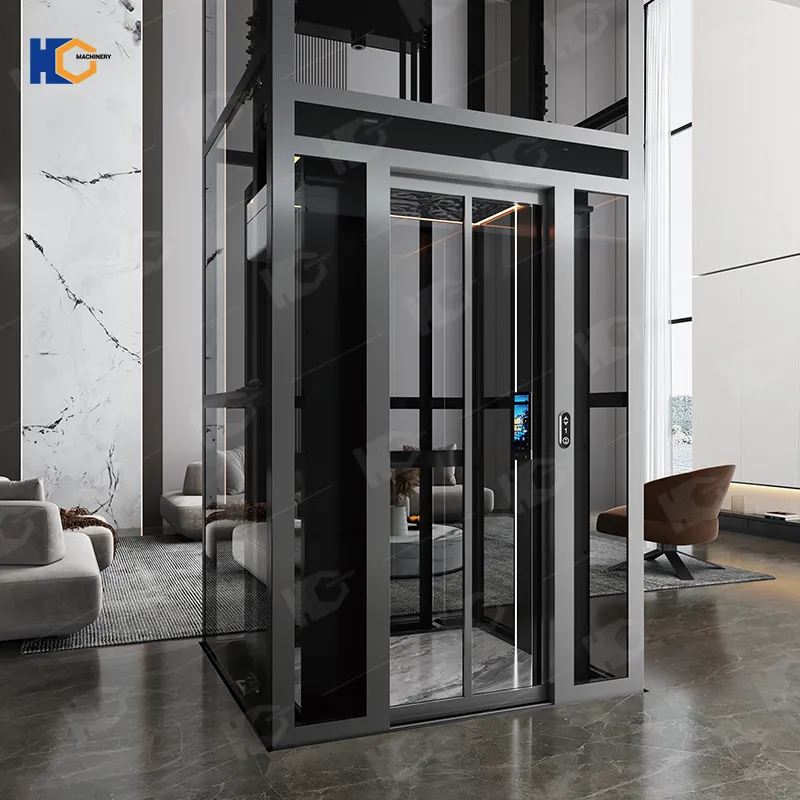
3. Screw-Driven Residential Elevator
A household screw elevator is an elevator that uses the meshing transmission of screws and nuts to achieve car lifting and lowering. It does not require a pit or computer room, occupies a small space, and is easy and flexible to install. Smooth operation, safe and reliable, with low noise. Due to its unique driving method, it can be manually operated even in the event of a power outage. Suitable for various home environments, especially for small residences and families with high space requirements.
Features & Functionality
Uses a rotating screw mechanism to lift the cabin, offering a simple and safe design.
Advantages
No machine room or deep pit required, allowing flexible installation.
Simple mechanical structure with low failure rates and easy maintenance.
Compact, ideal for small spaces.
Disadvantages
Slow speed (0.15-0.3 m/s), unsuitable for high-rise homes.
Slightly noisy due to mechanical friction.
Ideal For
Small homes, duplexes, or elderly-friendly residences, especially those without an existing shaft.
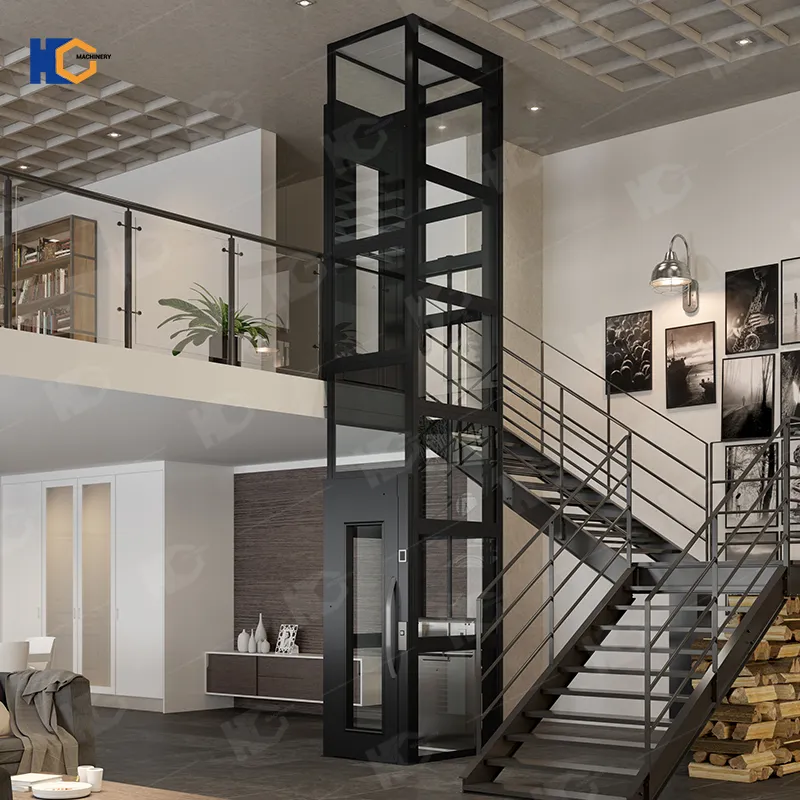
4. Pneumatic Residential Elevator
Pneumatic household elevators are elevators driven by air pressure differentials. It uses air as its power source and adjusts the air pressure inside the car through the top fan to achieve lifting. No need for the complex mechanical structure of traditional elevators, easy installation, no need for pit and machine room, saving space. Quiet operation, safe and reliable, low maintenance cost, suitable for various home environments, especially for small residences.
Features & Functionality
Uses air pressure differences to move the cabin, featuring a sleek, transparent shaft design.
Advantages
No machine room or pit needed, easy to install.
Fully transparent design, modern and stylish, perfect for high-end homes.
High safety; even during power outages, it descends slowly.
Disadvantages
Low weight capacity (≤200kg), suitable for only 1-2 people.
Higher price and maintenance costs.
Ideal For
Modern villas, lofts, or showcase homes where aesthetics are a priority.
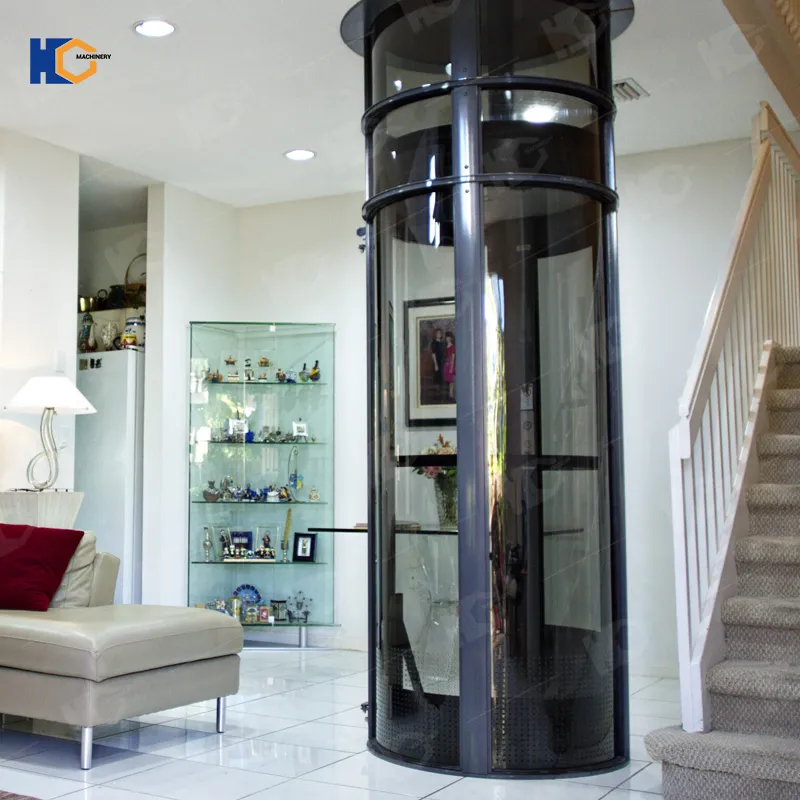
5. Chain-Driven Residential Elevator
Chain driven household elevators are a type of elevator that uses chain transmission to lift and lower the car. It is powered by an electric motor and drives the chain through a sprocket, thereby pulling the car to run. The structure is relatively simple, the cost is low, and the installation is convenient. However, the smoothness and safety of operation depend to some extent on the quality of the chain, which is suitable for small family residences with low requirements for speed and load capacity.
Features & Functionality
Similar to traction elevators but uses chains instead of cables, offering a more compact structure.
Advantages
Suitable for low-rise homes, flexible installation.
Lower cost and simple maintenance.
Disadvantages
Noisier operation, less comfortable.
Chains wear out and require periodic replacement.
Ideal For
Budget-conscious families in low-rise homes.
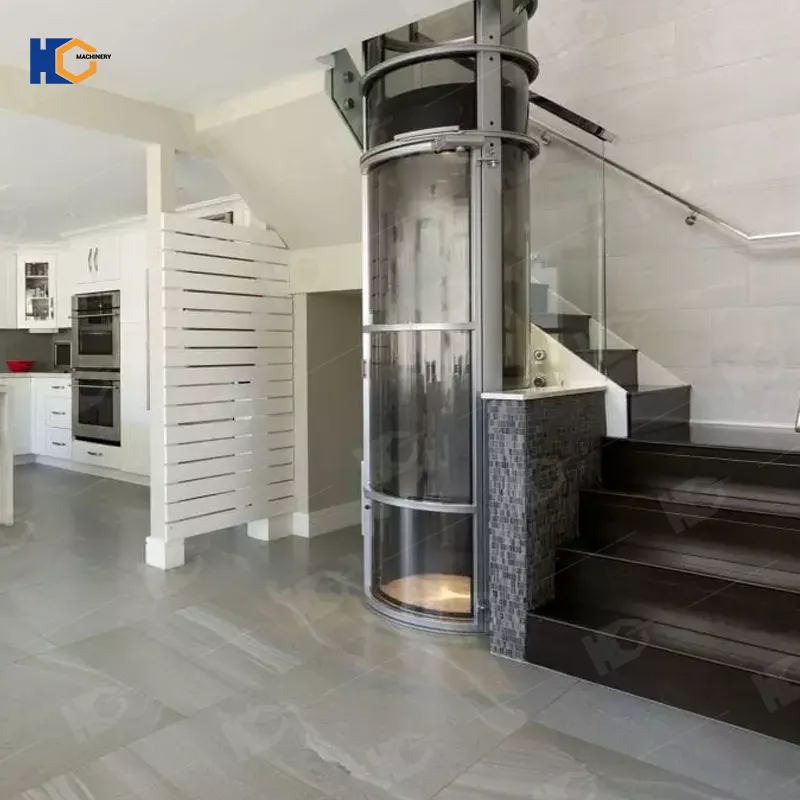
6. Machine-Room-Less (MRL) Residential Elevator
Non machine room household elevators are a type of elevator that does not require a separate machine room. It installs the drive host, control cabinet and other equipment in the shaft, saving space and suitable for residential buildings with limited space. It has a compact structure, flexible installation, simple and beautiful appearance, and relatively low noise during operation, which can be well integrated into the home environment. It is widely used in small family residences.
Features & Functionality
The drive system is integrated into the shaft, eliminating the need for a separate machine room.
Advantages
Saves space, ideal for compact homes.
Energy-efficient and smooth operation.
Disadvantages
Requires precise shaft dimensions, making retrofitting challenging.
Higher price and specialized maintenance needs.
Ideal For
Newly built villas or modern homes where space efficiency is key.
 Residential Elevator 458431.webp)
7. Stair lift
A household stair lift chair is a device that helps people with limited mobility to go up and down stairs. Divided by track, the straight line type is installed along the straight staircase, with a simple structure; The curved shape can adapt to complex curved stairs. Divided by seat, there are regular seats and folding seats (to save space). According to the driving method, electric models are widely used and easy to operate; The hydraulic type has sufficient power and stable operation, which can meet the needs of different household staircases and users.
Features & Functionality
Installed along stair railings, designed for single-person use.
Advantages
Lowest cost and easy installation.
Ideal for elderly individuals needing temporary assistance.
Disadvantages
Only for single-person use; cannot transport items.
Obstructs normal stairway access.
Ideal For
Budget-limited households needing temporary mobility support.

8. Platform Lift (Wheelchair Elevator)
Wheelchair Elevator, also known as a wheelchair lift, is a vertical transportation device designed specifically for people with limited mobility who use wheelchairs. It usually has a small load capacity, and the cabin space can accommodate wheelchairs and passengers. Structurally, there are platform type, cabin type, etc., and the driving methods include hydraulic, screw, etc. Featuring safety, reliability, and easy operation, it facilitates wheelchair users to easily climb up and down stairs, ensuring convenient travel.
Features & Functionality
Designed for wheelchair users, featuring an open platform for easy access.
Advantages
Barrier-free design, convenient for wheelchair users.
Compact, suitable for tight spaces.
Disadvantages
Slow speed, limited to low-rise use.
Basic appearance, less aesthetically appealing.
Ideal For
Households with disabled individuals or long-term wheelchair users.
 263002.webp)
9. AI-Powered Smart Elevator
Intelligent AI home elevators are a new type of elevator that integrates artificial intelligence technology. It can be controlled through commands such as voice and gestures, and can automatically recognize user needs and plan the optimal path. Equipped with intelligent security warning and real-time monitoring of operational status. It can also be interconnected with smart home systems, such as automatically adjusting indoor temperature according to the user's arrival, bringing a convenient, safe, and personalized elevator experience.
Features & Functionality
Incorporates AI for voice control, facial recognition, and smart monitoring.
Advantages
User-friendly, ideal for tech enthusiasts.
Remote monitoring enhances safety.
Disadvantages
Expensive, as the technology is not yet widespread.
Relies on electricity; backup power is needed during outages.
Ideal For
High-end smart homes with a focus on cutting-edge technology.
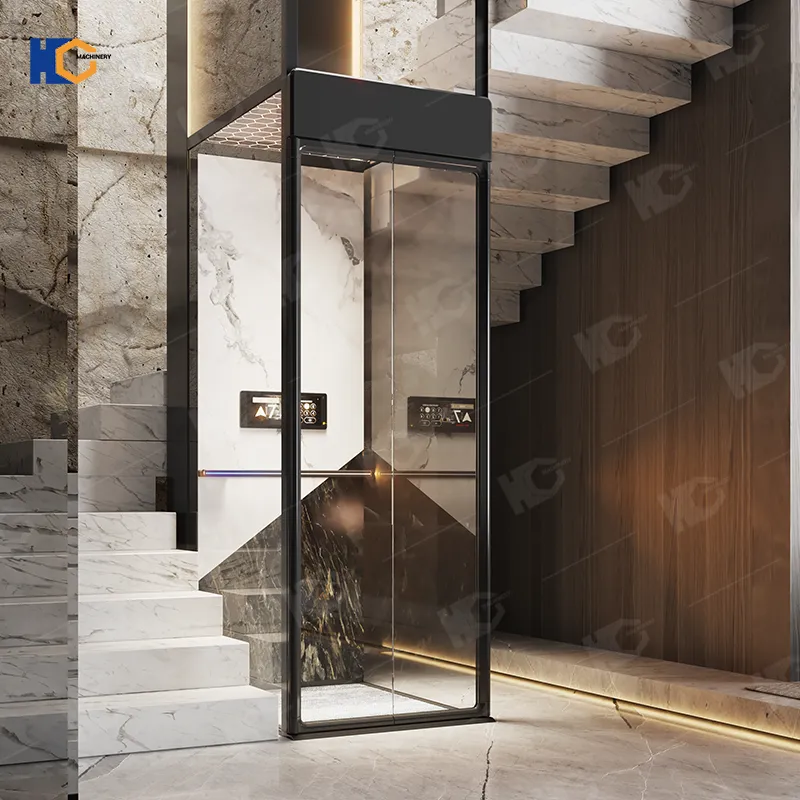
10. Outdoor Residential Elevator
There are several types of outdoor home elevators. The combination of steel structure frame and glass curtain wall is beautiful, with good lighting and a great view; Concrete structures are sturdy, durable, and highly safe; There are also aluminum alloy materials that are lightweight, corrosion-resistant, and easy to install. According to the driving mode, it can be divided into traction type, hydraulic type, screw type, etc., to meet different outdoor environments and household needs.
Features & Functionality
Designed for outdoor installation in villas, featuring weather-resistant construction.
Advantages
Does not occupy indoor space, perfect for landscaped homes.
Connects gardens, terraces, and multi-level outdoor areas.
Disadvantages
Requires anti-rust and anti-corrosion treatment, increasing maintenance costs.
Weather-dependent; extreme conditions may affect operation.
Ideal For
Villas with gardens, pools, or outdoor terraces.

How to Choose the Right Home Elevator?
Selecting a home elevator requires careful consideration of budget, space, functional needs, and aesthetic preferences. Below is a detailed buying guide, including price ranges (in USD), to help you make an informed decision.
1. Budget Considerations (Price Range)
Prices vary significantly depending on the drive system, brand, installation complexity, and features.
Elevator Type | Price Range (USD) | Value Analysis |
Hydraulic | 20,000−40,000 | High cost-performance, mid-to-high budget |
Traction | 25,000−50,000 | Energy-efficient, low long-term costs |
Screw Drive | 15,000−30,000 | Budget-friendly but slower |
Pneumatic | 35,000−70,000 | Stylish but expensive, ideal for luxury homes |
Chain Drive | 10,000−25,000 | Most affordable but less comfortable |
Machine-Room-Less (MRL) | 30,000−60,000 | Space-saving but higher installation costs |
Stairlift | 33,000−10,000 | Most economical, single-user only |
Platform Lift | 15,000−35,000 | Wheelchair-accessible, highly practical |
AI-Powered Elevator | 50,000−100,000 | High-tech, most expensive |
Outdoor Elevator | 30,000−70,000 | Weather-resistant, higher maintenance costs |
Budget Recommendations
Economical (10K−25K): Chain drive, screw drive, stairlift
Mid-Range (25K−50K): Hydraulic, traction, platform lift
Luxury ($50K+): Pneumatic, AI-powered, outdoor elevator
2. Space Requirements
Different elevators have varying space needs. Choose based on your home’s structure.
Elevator Type | Space Needed | Ideal for |
Hydraulic | Requires machine room or oil cylinder space | Large villas, standalone homes |
Traction | Needs a taller shaft (≥2.5m) | Homes with 3+ floors |
Screw Drive | No machine room, compact footprint | Small homes, duplexes |
Pneumatic | Transparent shaft, no pit needed | Modern villas, lofts |
Chain Drive | Compact, flexible installation | Low-rise homes |
Machine-Room-Less (MRL) | Drive system integrated into shaft | Space-constrained homes |
Stairlift | Installed along stairs, minimal space | Older homes, small spaces |
Platform Lift | Open design, fits narrow areas | Wheelchair users |
AI-Powered Elevator | Depends on model | High-tech smart homes |
Outdoor Elevator | Weatherproof structure required | Villas with gardens, patios |
Space Recommendations
Small homes/duplexes: Screw drive, pneumatic, stairlift
Large villas/multi-story homes: Hydraulic, traction, MRL
Outdoor/landscaped homes: Outdoor elevator
3. Functional Needs
Different household needs influence elevator choice, especially for seniors, wheelchair users, or heavy lifting.
Need | Recommended Elevator | Reason |
Seniors/mobility issues | Hydraulic, platform lift, stairlift | Smooth operation, accessible design |
Wheelchair users | Platform lift, hydraulic | Spacious, easy wheelchair access |
Heavy lifting | Hydraulic, traction | High load capacity (300-500kg) |
Temporary assistance | Stairlift | Low-cost, quick installation |
High-tech experience | AI-powered elevator | Voice control, facial recognition |
Functional Recommendations
Aging households: Prioritize hydraulic or platform lifts (safe and stable)
Disabled users: Platform lifts (barrier-free design)
Heavy lifting: Hydraulic or traction (high weight capacity)
4. Aesthetic Preferences
Elevator design impacts home aesthetics, especially in luxury residences.
Elevator Type | Aesthetic Appeal | Design Features |
Pneumatic | ★★★★★ | Fully transparent shaft, modern look |
AI-Powered Elevator | ★★★★★ | High-tech interface, customizable |
Outdoor Elevator | ★★★★☆ | Blends with architectural style |
Traction | ★★★☆☆ | Traditional, functional |
Hydraulic | ★★★☆☆ | Customizable cabin but requires hidden machine room |
Aesthetic Recommendations
Modern style: Pneumatic, AI-powered elevator
Traditional/practical style: Traction, hydraulic
Conclusion: How to Choose the Best Home Elevator?
Set a budget first:
Economical: Screw drive, chain drive (10K−25K)
Mid-range: Hydraulic, traction (25K−50K)
Luxury: Pneumatic, AI-powered elevator ($50K+)
Consider space constraints:
Small homes → Screw drive, pneumatic
Large villas → Hydraulic, traction
Outdoor needs → Outdoor elevator
Match functional needs:
Seniors/wheelchair users → Platform lift, hydraulic
Heavy lifting → Traction
Temporary assistance → Stairlift
Prioritize aesthetics if needed:
Sleek and transparent → Pneumatic
High-tech → AI-powered elevator
Final Recommendations
Best value for money: Traction elevator (balances price, performance, and energy efficiency)
Best for small homes: Screw drive elevator (no machine room, flexible installation)
Top choice for luxury homes: Pneumatic or AI-powered elevator (stylish + high-tech)
Hope this guide helps you find the perfect home elevator!
Conclusion
Residential elevators come in various types, and the choice depends on budget, space, household needs, and design preferences. Hydraulic and traction elevators suit most families, screw-driven and pneumatic models are ideal for small homes, while AI-powered and outdoor elevators cater to high-end residences. We hope this guide helps you find the perfect residential elevator solution!
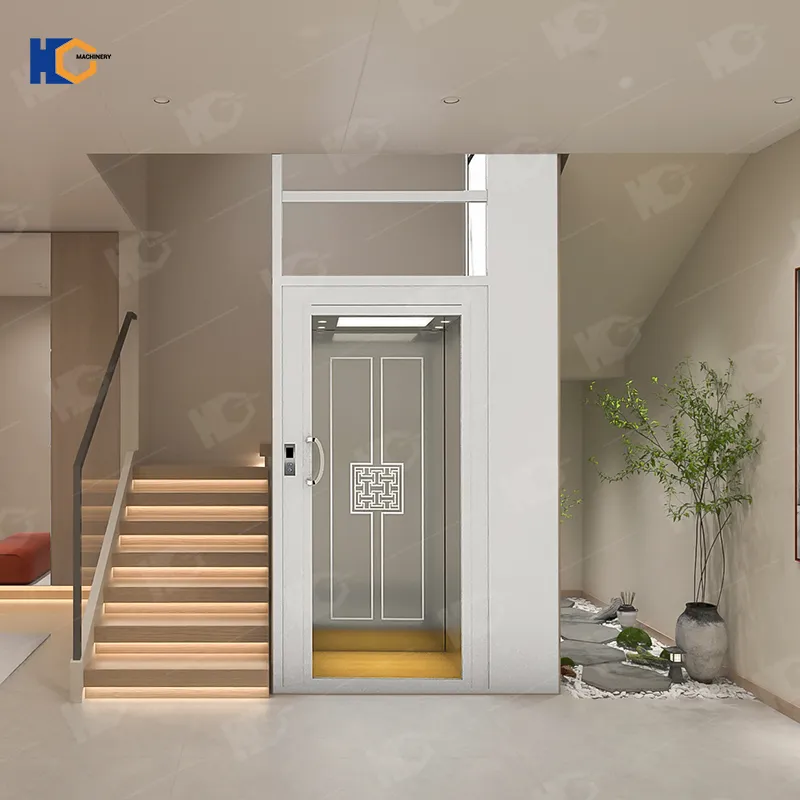
824.webp)
322.webp)
222.webp)